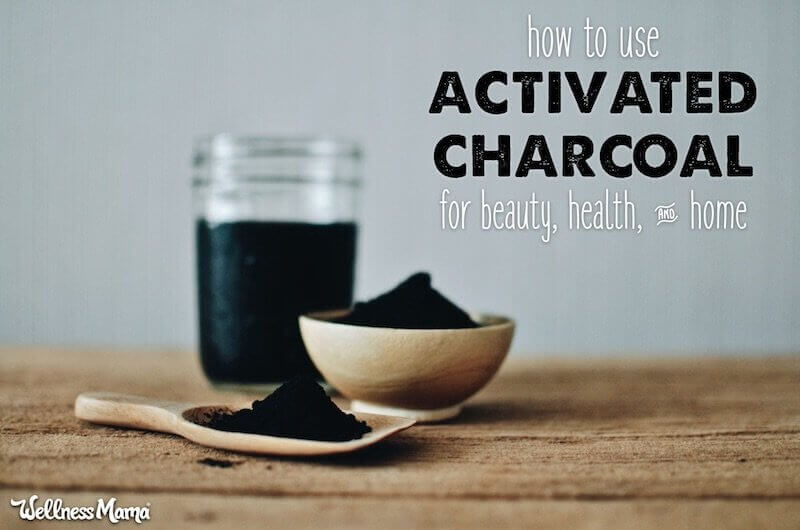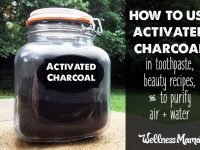
Activated charcoal has been part of my natural medicine cabinet for years, but now it is showing up in beauty magazines and DIY websites for its many other uses!
Activated charcoal is one of those rare areas where ancient traditional medicine and today’s medical literature agree. Ayurvedic and Chinese medicine used this sooty, jet-black powder for thousands of years. (Its first recorded use dates back to 1550 BC.) It is also well established in medical literature as a powerful antidote that adsorbs most organic toxins, chemicals, and poisons before they can harm the body.
Interest in activated charcoal grew in 1831 when a French Academy of Medicine professor famously drank a lethal dose of strychnine and did not suffer any ill effects … all because he combined it with activated charcoal.
Oddly enough, I also brush my teeth with it … so there are other reasons to have activated charcoal around!
What Is Activated Charcoal?
It is important to know right from the get-go that activated charcoal is not the same thing as charcoal for your grill or charred wood from the fire. Please don’t try to substitute or make your own
Activated charcoal consists of some substance—usually bamboo, wood, coal, or my preference, coconut shell charcoal—burned without oxygen to create char. The char is then heated to a high temperature and exposed to certain gases through a multi-step process to make it extremely porous. This is the “activation” part of the process.
Once activated, the increased surface area of the molecules can bind powerfully to any substance. This process of adsorption (not to be confused with absorption) is what makes charcoal so powerful. True activated charcoal is odorless, tasteless, and nontoxic.
Benefits of Activated Charcoal Use
There are 3 main benefits to having activated charcoal in a healthy mama’s bag of tricks:
1. Poison and Toxin Remedy
Studies show that activated charcoal may be the most effective GI tract decontaminant available. It can adsorb up to 50-60% of unwanted substances in the stomach and intestines when taken quickly after ingestion. It can even have a positive effect as long as two hours after ingestion!
In fact, emergency rooms routinely administer large doses of activated charcoal for certain types of poisoning. Unlike ipecac syrup or stomach pumping, activated charcoal binds with and removes much of the offending substance even after it enters the bloodstream.
Of course, anyone who experiences poisoning or exposure to toxic substances should absolutely contact a poison control center or hospital immediately and follow any instructions they have. I know of cases where a poison center instructed someone to administer charcoal at home and then follow up in the ER.
Activated charcoal’s power to purify is also why it’s routinely used in water and air filters.
2. Oral Care
The same properties that make charcoal beneficial for removing harmful substances in the digestive system also make it beneficial for oral health as well. It doesn’t neutralize toxins, but rather binds them to the many tiny pores on its surface.
When used in toothpastes, powders, and oral health rinses, it can bind to bacteria and other harmful substances and remove them from the mouth. Many people like using it in this way because it also binds to substances that stain the teeth and can whiten the teeth in only a few uses.
3. Beauty Ingredient
Activated charcoal is showing up in many beauty products lately too. This is because it is effective at removing bacteria, chemicals, dirt, and build-up on the skin. Check out all the beauty uses below or try mixing it into a face wash or scrub. (Don’t worry … it washes off!)
Ways to Use Activated Charcoal (for Home & Beauty)
I keep activated charcoal on hand in case any of the kids ever accidentally ingest any household toxins or chemicals, though we also do our best to keep anything toxic out of the house completely. Thankfully, we haven’t yet had to use it for that purpose!
I find myself turning to charcoal almost daily for other uses though:
1. To Whiten Teeth Naturally
This is the first beauty use for charcoal that I tried, and it worked wonderfully!
Read all about my charcoal teeth whitening experiment here but the method is simple. Just dip a wet toothbrush in a high quality charcoal and brush gently. Alternately, you can swish with charcoal water by mixing 1/2 teaspoon of charcoal into a small amount of water.
Charcoal is mildly abrasive so be gentle and don’t do this more than once or twice a week!
2. In Toothpaste
Similarly, charcoal can be used in toothpastes and tooth powders to get the same effect. I wouldn’t use these daily, since they are abrasive, but adding a little charcoal to a homemade toothpaste or DIY tooth powder a couple times a week can whiten and freshen the teeth.
There are also pre-made options like Magic Mud toothpaste that have clean ingredients and work really well!
3. As a Face Mask or Cleanser
I love using charcoal on my skin. Fair warning, it looks a little bizarre to paint this stuff all over your face, but it does wash off and leaves skin super soft!
For a mask: Easily make your own mask with this simple recipe or buy a high quality pre-made natural mask like this one.
As a cleanser: Mix 1/2 teaspoon of activated charcoal powder into a face wash and scrub skin gently. Rinse well and pat dry.
4. In Shampoo
Charcoal has been showing up in shampoos for the same reason people love it in facial products. It removes build up and impurities. The easiest way to try this is to add a tiny amount (1/2 teaspoon) to shampoo before washing hair. Scrub gently and wash out.
I’ve yet to find a pre-made shampoo with good ingredients so just add to a natural shampoo that you like! I’ve added charcoal to this natural shampoo with good results.
5. Clean the Air
Charcoal’s porous structure makes it great at removing odors, harmful chemicals and allergens from the air. This is why you’ll often find charcoal in air purifying products. These charcoal bags are the easiest way to use charcoal to clean the air in a home. They last for years and can be recharged by putting them in the sun once a month or so.
6. Purify Water
Activated charcoal also helps remove contaminants from water. It is used in the Berkey system that our family used for years and even in most water pitcher systems. The 14-stage filter we have now also uses charcoal to filter water.
7. Relieve Bug Bites
I use charcoal in my drawing salve for its ability to draw out irritants. This recipe is also great for applying to bug bites to relieve itching and pain! But charcoal alone can also help draw out venom.
In one scary episode, I used charcoal to treat a spider bite on my son’s leg after we had confirmation that it was likely a brown recluse bite. Our doctor confirmed that the conventional approach is “wait and see.” I wasn’t comfortable with this, especially since my son was uncomfortable. A mix of charcoal and baking soda helped draw the toxin out, and he healed with no long-term scarring.
Is Activated Charcoal Safe?
Activated charcoal is not known to be toxic, though it should not be taken within two hours of vitamins or medications because it will keep the body from adsorbing them. I personally would not take charcoal on a regular basis and would only use as needed.
As with any substance, you should always check with a doctor or medical professional before internal use, especially in an emergency or life-threatening situation or if there is any other underlying health problem.
Remember, activated charcoal is NOT the same thing as the ashes from burning wood or other fires at home, so please don’t try to use those type of ashes for these or any other uses!
I also don’t recommend activated charcoal-infused food or drinks. Charcoal can bind to the nutrients in food or drinks, making these less nourishing rather than enhancing them. The one exception? Charcoal cocktails are getting more popular, and since alcohol is a toxin anyway, these may be worth trying. In fact some experts recommend charcoal as a hangover remedy.
Where to Get Activated Charcoal
I keep this brand of activated charcoal on hand because it is made from coconut shells and is the most pure source I’ve personally found. I store it in a glass jar and usually keep it on the bathroom sink since we typically just use it for teeth.
Fair warning: Activated charcoal is EXTREMELY messy if spilled. It will easily wash out of a sink or bathroom counter but isn’t so easy to get out of rough surfaces like tile grout (don’t ask how I know). I recommend keeping this out of the reach of children or messy pets for that reason!
This article was medically reviewed by Dr. Scott Soerries, MD, Family Physician and Medical Director of SteadyMD. As always, this is not personal medical advice and we recommend that you talk with your doctor.
Ever used activated charcoal? What did you use it for? Share below!
Sources:
- Derlet, R. W., & Albertson, T. E. (1986). Activated Charcoal—Past, Present and Future. Western Journal of Medicine, 145(4), 493–496.
- Guss, D. A. (1989). Emergency Medicine: Activated Charcoal—The First-Line Agent in Cases of Overdose. Western Journal of Medicine, 151(1), 63.